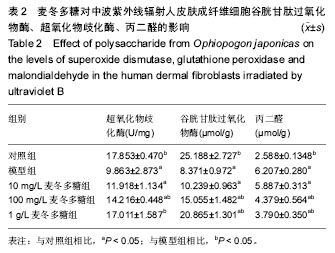中国组织工程研究 ›› 2017, Vol. 21 ›› Issue (32): 5183-5188.doi: 10.3969/j.issn.2095-4344.2017.32.017
• 组织构建细胞学实验 cytology experiments in tissue construction • 上一篇 下一篇
麦冬多糖对中波紫外线损伤人皮肤成纤维细胞的保护作用
陈高敏,王 璐,杜 沛,李中平,沈红艺
- (上海中医药大学公共健康学院,上海市 201203)
Polysaccharide from Ophiopogon japonicus protects against ultraviolet B damage to the human dermal fibroblasts
Chen Gao-min, Wang Lu, Du Pei, Li Zhong-ping, Shen Hong-yi
- (School of Public Health, Shanghai University of Traditional Chinese Medicine, Shanghai 201203, China)
摘要:
文章快速阅读:
.jpg) 文题释义:
人皮肤成纤维细胞:是真皮层主要的组成细胞,负责分泌前胶原至细胞外,经相关酶的代谢与真皮细胞外基质蛋白结合(例如小分子的蛋白多糖)成三螺旋空间复合体,最终形成结构规则的胶原纤维束,为皮肤提供韧性和抗拉性。对于维持皮肤正常光滑润泽的生理状态具有重要意义。
皮肤光老化:皮肤老化可分为内源性老化和外源性老化。内源性老化指随着时间的推移,由于机体功能下降,皮肤组织呈现的老化。外源性老化由外界众多环境因素引起,其中太阳光中的紫外线是最重要诱导因素。因此,外源性老化又称为光老化。光老化约占人体裸露部位皮肤老化80%。
文题释义:
人皮肤成纤维细胞:是真皮层主要的组成细胞,负责分泌前胶原至细胞外,经相关酶的代谢与真皮细胞外基质蛋白结合(例如小分子的蛋白多糖)成三螺旋空间复合体,最终形成结构规则的胶原纤维束,为皮肤提供韧性和抗拉性。对于维持皮肤正常光滑润泽的生理状态具有重要意义。
皮肤光老化:皮肤老化可分为内源性老化和外源性老化。内源性老化指随着时间的推移,由于机体功能下降,皮肤组织呈现的老化。外源性老化由外界众多环境因素引起,其中太阳光中的紫外线是最重要诱导因素。因此,外源性老化又称为光老化。光老化约占人体裸露部位皮肤老化80%。
.jpg) 文题释义:
人皮肤成纤维细胞:是真皮层主要的组成细胞,负责分泌前胶原至细胞外,经相关酶的代谢与真皮细胞外基质蛋白结合(例如小分子的蛋白多糖)成三螺旋空间复合体,最终形成结构规则的胶原纤维束,为皮肤提供韧性和抗拉性。对于维持皮肤正常光滑润泽的生理状态具有重要意义。
皮肤光老化:皮肤老化可分为内源性老化和外源性老化。内源性老化指随着时间的推移,由于机体功能下降,皮肤组织呈现的老化。外源性老化由外界众多环境因素引起,其中太阳光中的紫外线是最重要诱导因素。因此,外源性老化又称为光老化。光老化约占人体裸露部位皮肤老化80%。
文题释义:
人皮肤成纤维细胞:是真皮层主要的组成细胞,负责分泌前胶原至细胞外,经相关酶的代谢与真皮细胞外基质蛋白结合(例如小分子的蛋白多糖)成三螺旋空间复合体,最终形成结构规则的胶原纤维束,为皮肤提供韧性和抗拉性。对于维持皮肤正常光滑润泽的生理状态具有重要意义。
皮肤光老化:皮肤老化可分为内源性老化和外源性老化。内源性老化指随着时间的推移,由于机体功能下降,皮肤组织呈现的老化。外源性老化由外界众多环境因素引起,其中太阳光中的紫外线是最重要诱导因素。因此,外源性老化又称为光老化。光老化约占人体裸露部位皮肤老化80%。摘要
背景:随着环境日益恶化,大气臭氧层破坏严重,辐照到地球表面的中波紫外线也日渐增加,防治中波紫外线引起的皮肤光老化意义重大。
目的:观察麦冬多糖对中波紫外线诱导的人皮肤成纤维细胞光老化损伤的保护作用,探讨其作用机制。
方法:实验将人皮肤成纤维细胞分为5组,对照组不光照,无药培养液培养;其余4组均给予200 mJ/cm2的中波紫外线照射建立细胞光老化模型,模型组光照后给予无药培养液培养;各麦冬多糖给药组光照后分别给予10 mg/L、100 mg/L、1 g/L的麦冬多糖培养液培养。培养48 h后CCK-8检测细胞生存率;试剂盒法测定细胞内超氧化物歧化酶、谷胱甘肽过氧化物酶活性及丙二醛含量;利用荧光定量PCR法测定光老化人皮肤成纤维细胞中基质金属蛋白酶1、基质金属蛋白酶3、c-Jun基因表达量。
结果与结论:①200 mJ/cm2的中波紫外线可以降低人皮肤成纤维细胞生存率,超氧化物歧化酶、谷胱甘肽过氧化物酶活性降低,丙二醛含量升高,基质金属蛋白酶1、基质金属蛋白酶3、c-Jun基因表达量增加,与对照组相比差异均有显著性意义(P < 0.05);②给予10 mg/L、100 mg/L、1 g/L的麦冬多糖均能提高中波紫外线损伤的人皮肤成纤维细胞生存率,升高细胞内超氧化物歧化酶、谷胱甘肽过氧化物酶活性,降低丙二醛含量,降低受损细胞内基质金属蛋白酶1、基质金属蛋白酶3、c-Jun基因表达量;③综上,麦冬多糖能减轻中波紫外线对人皮肤成纤维细胞的损伤,其机制可能是通过缓解中波紫外线诱导的氧化应激,抑制相应信号转导通路,降低光老化细胞内c-Jun表达,进而抑制基质金属蛋白酶1、基质金属蛋白酶3表达,减少皮肤胶原蛋白损伤。
中国组织工程研究杂志出版内容重点:组织构建;骨细胞;软骨细胞;细胞培养;成纤维细胞;血管内皮细胞;骨质疏松;组织工程
ORCID: 0000-0001-5706-3297(陈高敏)
中图分类号:


.jpg) 文题释义:
人皮肤成纤维细胞:是真皮层主要的组成细胞,负责分泌前胶原至细胞外,经相关酶的代谢与真皮细胞外基质蛋白结合(例如小分子的蛋白多糖)成三螺旋空间复合体,最终形成结构规则的胶原纤维束,为皮肤提供韧性和抗拉性。对于维持皮肤正常光滑润泽的生理状态具有重要意义。
皮肤光老化:皮肤老化可分为内源性老化和外源性老化。内源性老化指随着时间的推移,由于机体功能下降,皮肤组织呈现的老化。外源性老化由外界众多环境因素引起,其中太阳光中的紫外线是最重要诱导因素。因此,外源性老化又称为光老化。光老化约占人体裸露部位皮肤老化80%。
文题释义:
人皮肤成纤维细胞:是真皮层主要的组成细胞,负责分泌前胶原至细胞外,经相关酶的代谢与真皮细胞外基质蛋白结合(例如小分子的蛋白多糖)成三螺旋空间复合体,最终形成结构规则的胶原纤维束,为皮肤提供韧性和抗拉性。对于维持皮肤正常光滑润泽的生理状态具有重要意义。
皮肤光老化:皮肤老化可分为内源性老化和外源性老化。内源性老化指随着时间的推移,由于机体功能下降,皮肤组织呈现的老化。外源性老化由外界众多环境因素引起,其中太阳光中的紫外线是最重要诱导因素。因此,外源性老化又称为光老化。光老化约占人体裸露部位皮肤老化80%。